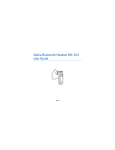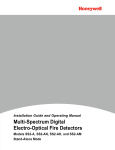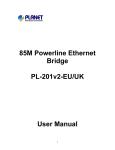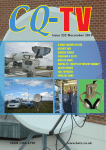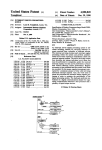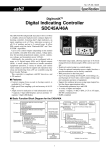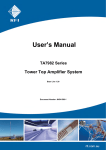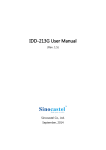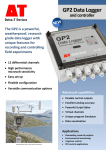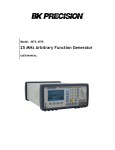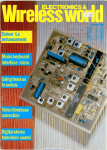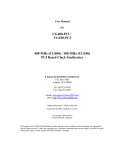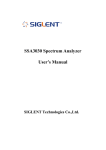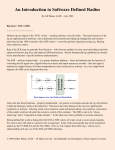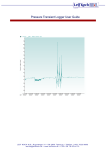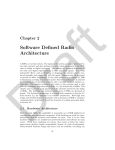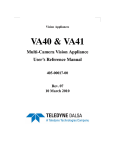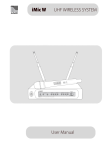Download FlexRadio FLEX-3000 HF and 50MHz SDR Transceiver
Transcript
EQUIPMENT REVIEW PETER HART, G3SJX ♦ E-MAIL: [email protected] AUGUST 2009 ♦ RADCOM FlexRadio FLEX-3000 HF and 50MHz SDR Transceiver INTRODUCTION. FlexRadio Systems has recently added another transceiver to their range of innovative software defined radios. The FLEX-3000 is a new model, smaller and lower in cost compared to the FLEX-5000A that was reviewed in the January 2008 and March 2009 issues of RadCom. The FLEX-3000 received CE certification in May and first deliveries to Europe started in June. With a footprint and height similar to a laptop PC, it uses the same architecture as the FLEX-5000A and feature set provided by the same PowerSDR software. 24 COMPARISON WITH FLEX-5000A. The FLEX-5000A uses a modular construction with plenty of space to add additional boards such as an ATU, second receiver and transverter. The FLEX-3000 uses two PCBs mounted on a flat bottom plate with no provision for expansion. A single hardware receiver is accommodated but the PowerSDR software allows for two separate and isolated receive channels within a 96kHz receive window. No duplex, cross-band or cross-mode operation is possible. The FLEX-3000 does, however, include a built-in auto ATU that is only selectable if the antenna match is poor. There is a single antenna socket (BNC connector), no provision for separate receiver antenna and the audio line input/output and switching interfaces are more limited for the FLEX3000. However, the receiver frequency range and transmit output power are the same. The panadaptor spectrum display is limited to 96kHz and the front-end filtering in the FLEX-3000 is significantly reduced. The claimed dynamic range figures are lower than for the FLEX5000A, probably because a lower specified ADC is used, but the cost is considerably less. SYSTEM HARDWARE. The FLEX-3000 is used in conjunction with a PC and a Firewire bus provides all control for the hardware and the digitised transmit and receive IF paths. A sound card is not required in the PC. The receiver tunes from nominally 100kHz to 60MHz. Incoming signals are down-converted to a low IF using a pair of quadrature sampling detectors as an image rejection mixer. The IF is set by default to 9kHz but can be set by the software to be in the range 0Hz to 20kHz. Image rejection is the principal weakness with this architecture although software trimming reduces the image to quite low levels. A spur reduction mode is provided that allows the IF to vary between about 9 and 16.6kHz, coarse stepping the DDS in 7.6kHz steps and fine tuning by the DSP at the IF. This moves the image frequency and hopefully helps when image or other spurs are a problem. The resulting I and Q outputs from the mixers are fed to 24-bit A/D converters and thence to the PC for all signal processing. Local oscillator drive in quadrature to the two mixers is obtained directly from a high frequency Direct Digital Synthesiser (DDS) IC tuning in 1Hz steps. The receiver front-end uses 5th order bandpass filters (7th order on 160m) and a total of seven filters covers the tuning range of the radio. In comparison, the FLEX-5000 uses higher performance 11th order filters, one for each amateur band. A nominal 26dB gain front-end preamplifier can be selected on bands above 160m, or a 20dB front-end attenuator for very strong signals. On transmit, a similar pair of quadrature mixers and DDS is used to up-convert the quadrature transmit signal from the PC via the Firewire bus and on-board 24-bit D/A converters to give the transmit signal source. This is then amplified using power MOSFET transistors and low-pass filtered to give the required 100W output power. An auto ATU is built in, using relay-switched inductors and capacitors. The radio is powered from an external 13.8V power supply, drawing up to 25A on transmit. The circuitry is contained on two printed circuit boards mounted on a base plate and a thin heatsink is blown by two fans which are quite noisy, particularly on transmit. This assembly fits into a wrap-around case measuring 311mm (w) x 44mm (h) x 311mm (d). The only controls on the front panel are the illuminated on/off switch, headphone jack, RJ-45 microphone socket (Yaesu compatible pinning) and CW key jack. The rear panel contains a BNC antenna socket, PTT input, TX grounded output, audio line in (via FlexWire socket) and audio line out. Computer style powered speakers can be connected to the audio line out socket. The 9-pin D connector FlexWire interface provides control for a future range of accessories using I2C bus control. The Firewire computer interface uses the IEEE1394a 400Mb/s standard and not the higher speed 1394b standard. SYSTEM SOFTWARE. Apart from the hardware functions already described, the remaining features and functions of the radio are defined largely by the PowerSDR software, which runs on the PC. This software is common to the FLEX-5000 and hence both radios share the same user interface and software-related feature set. PowerSDR is constantly being developed and improved as freely available GPL open source code. Code updates are quite frequent and are released via the FlexRadio website at www.flex-radio.com. The feature set is quite awesome, there are probably more features and functions than any other top end radio currently available. The core feature set was described in the FLEX-5000A review in the January 2008 RadCom and will not be repeated here but a full description of all the features is included in the FLEX-3000 user manual, which runs to nearly 200 pages. Paper manuals are not included with the radio, except for a quick start guide. All files and manuals are provided on CDROM RADCOM ♦ AUGUST 2009 but the latest versions of all are readily downloadable from the FlexRadio website. The first step to getting the radio up and running is to install the driver and system firmware either from the supplied CDROM or from the FlexRadio website. All software is compatible with Windows Vista and XP operating systems. The next step is to install the PowerSDR software and then finally a few configuration set-ups. The whole process takes about 10 minutes. The radio is supplied fully calibrated, including image nulling, although this can be optimised with some care. FlexRadio have completed an adaptive nulling routine termed ‘Wide Band Image Rejection’ or WBIR and this was demonstrated at Dayton this year. This will reduce images down to the noise floor automatically as the frequency is changed and will be issued this summer. A fast PC is a definite advantage as it minimises time delays (latency) and enables additional applications such as RTTY or PSK to be used via the Virtual Audio Cable without problems. A Firewire IEE1394 interface is of course required and the radio is provided with a 6 pin lead. A 6-pin to 4-pin adaptor or separate lead will be needed with laptop computers where this smaller socket is fitted. I used my Dell laptop PC with a 1.3GHz Celeron M processor, which is quite old now, with generally satisfactory results, but a faster PC would be better. MEASUREMENTS. The measured performance is shown in the table. The preamplifier gain is some 10dB higher than the FLEX-5000A and although the sensitivity is similar with the preamplifier off, it is significantly better than the FLEX-5000A with the preamplifier on. The sensitivity EQUIPMENT REVIEW than measured for the FLEX-5000A. I was drops rapidly at unable to measure intermodulation limited lower frequencies dynamic range and third order intercept as below 500kHz reciprocal mixing noise dominated and at and is not really higher levels ADC overload occurred. usable at LF. Similarly, blocking could not be measured Additional frontbut I had the impression that the front-end end bandpass had good strong signal performance. Inband filters are needed distortion levels are extremely low and this for MF broadcast makes for a very clean sounding receiver. reception to Transmit intermodulation products on suppress images SSB were generally reasonable on the middle and harmonic breakthrough. The bands but poor on the low and high bands. It is important to set the microphone gain image rejection at correctly. A helpful TX mic meter setting is 18kHz below the provided for this purpose. The CW keying receive frequency envelope was clean and well shaped with varied across the negligible character shortening. A delay bands from 44dB of about 40ms resulted with my laptop, it to 69dB with the should be shorter with a faster PC. This factory default delay is about half of that measured with calibration, which falls rather short of the FLEX-5000A and an earlier version of PowerSDR. the published specification of ON-THE-AIR PERFORMANCE. As might be 70dB. It is expected, the overall operating experience possible, with some degree of effort, to null was similar to the FLEX-5000A. I found out the image to over 70dB but the settings the on-air performance of the radio very do not hold over the band (but see comment impressive. The receiver sounded very in the Conclusions). Switching-style mixers respond to harmonic frequencies. Rejection of clean and low noise. The audio quality is excellent and the filter arrangements are 2nd and 3rd harmonics was typically some really effective. There is no click when the 70 to 90dB (worst case 65dB). The higher order filters used in the FLEX-5000 remove any harmonic response FLEXRADIO SYSTEMS FLEX-3000 MEASURED entirely. A number of weak spurious PERFORMANCE signals or birdies were audible on RECEIVER MEASUREMENTS most bands and visible on the ---SENSITIVITY SSB 10dBs+n:n--spectrum display but, to be fair, FREQUENCY PREAMP IN PREAMP OUT these were largely below band noise 1.8MHz 1.1µV (-106dBm) 3.5MHz 0.70µV (-110dBm) 1.1µV (-106dBm) level except on the quieter higher 5MHz 0.28µV (-118dBm) 1.0µV (-107dBm) frequency bands. 7MHz 0.16µV (-123dBm) 1.0µV (-107dBm) 10MHz 0.16µV (-123dBm) 1.3µV (-105dBm) The S-meter showed a very linear 14MHz 0.13µV (-125dBm) 1.0µV (-107dBm) indication with 50µV for S9 and 6dB 18MHz 0.13µV (-125dBm) 1.4µV (-104dBm) per S unit. The display indicates 21MHz 0.13µV (-125dBm) 1.3µV (-105dBm) 24MHz 0.11µV (-126dBm) 1.4µV (-104dBm) signal input in dBm with an excellent 28MHz 0.14µV (-124dBm) 2.2µV (-100dBm) accuracy of about ±2dB. The AGC 50MHz 0.13µV (-125dBm) 2.8µV (-98dBm) attack characteristic interrupts the AM sensitivity (28MHz): 0.7µV for 10dBs+n:n at 30% mod FM signal for 5 to 10ms change to and sensitivity (28MHz): 0.16µV for 12dB SINAD 3kHz pk dev Inband intermodulation products: <-50dB can impair readability of weak signals under noisy conditions. TRANSMITTER MEASUREMENTS I have seen this effect on a number ---CW---INTERMODULATION of IF DSP radios. Channel selectivity -POWER------PRODUCTS-----FREQUENCY OUTPUT HARMONICS 3rd order 5th order measurements were not made as 1.8MHz 95W -55dB -25dB -39dB this is determined by the PowerSDR 3.5MHz 97W -50dB -24dB -38dB software and will be the same as for 7MHz 100W -68dB -30dB -36dB 10MHz 99W -57dB -34dB -34dB the FLEX-5000A. 14MHz 99W -58dB -38dB -36dB Reciprocal mixing measurements 18MHz 100W -54dB -41dB -38dB were independent of frequency 21MHz 106W -64dB -34dB -36dB 24MHz 986W -57dB -29dB -36dB spacings from 1kHz out to beyond 28MHz 102W -66dB -26dB -36dB 300kHz. On 21MHz this yielded a 50MHz 98W -59dB -22dB -38dB phase noise limited dynamic range of Intermodulation product levels are quoted with respect to PEP. 87dB in 2.1kHz bandwidth (93dB in Sideband and carrier suppression: 60dB 500Hz bandwidth or –120dBC/Hz). Transmitter AF distortion: much less than 1% Microphone input sensitivity: 0.2mV to 30mV for full output The performance degraded at the NOTE: All signal input voltages given as PD across antenna lower frequencies and on 1.8MHz terminal. Unless stated otherwise, all measurements made on was 9dB worse. These results are USB with 2.1kHz bandwidth filter selected. rather poor and some 5 to 9dB worse 25 EQUIPMENT REVIEW AUGUST 2009 ♦ RADCOM The audio quality on transmit using a Heil Handi Mic HM-5 was excellent, and CW effective but the fans seemed very noisy. It is a matter of personal preference how you view the computer keyboard as your sole interface to your radio. Some feel it is the way forward, highly flexible and features such as point and click tuning enable rapid frequency navigation. Others, including myself, prefer the traditional approach with round knobs, switches and a good tuning dial. headphones are connected: this problem with the FLEX-5000A has been fixed. The panadaptor display adds another dimension to tuning and keeps you aware of signals on adjacent channels. DSP noise reduction, noise blanking and other receiver features all worked very well indeed. I did not experience FEATURE any problems due to intermodulation or overload but images could be heard from strong broadcasters and strong amateur stations. The ability to receive on two channels simultaneously in stereo within the IF band was excellent, just what is needed for DX split frequency working. WEBSEARCH FlexRadio Systems: www.flex-radio.com ELAINE RICHARDS, G4LFM ♦ E-MAIL: [email protected] Gerald Youngblood, the name behind FlexRadio INTERVIEW. At Dayton Hamvention this year, I was fortunate to have a chat with Gerald Youngblood, the man behind FlexRadio. 26 CONCLUSIONS. The FLEX-3000 with PowerSDR software is a most impressive radio. Although some aspects of performance are not as good as the FLEX-5000A, it is nevertheless an excellent performer and a significant price saving over its larger brother. There has been a substantial price increase over the last year on many US products. The FLEX-3000 is priced at £1395 inc VAT, almost half the current price of the FLEX-5000A with ATU. My thanks to Waters and Stanton PLC for the loan of the radio. You were interested in amateur radio at a young age, when were you first licensed? I got my licence in 1967 when I was a teenager in high school around the age of 15 or 16. Somebody gave me an old military surplus radio. It was about two feet long and so full of parts you couldn’t lift it. I was fascinated. I took every part out of it and sorted it. I didn’t know what the parts were but I was fascinated by the electronics in it. A friend of mine in ninth grade got his ham licence and had a Hammarlund receiver and some home-brew kit. I started working toward a licence when we moved to a new town and I found an ‘Elmer’. I moved to this small town that had something called a two year college. The physics teacher in the college took me under his wing and taught me about ham radio. I bought a Hallicrafters S38 receiver – I think I paid something like $30 for it – and my teacher helped me build a 6L6 transmitter and I got my Novice licence. I got on the air and worked 80m and 75m and made a lot of friends doing that. That was probably tenth grade and so, through that, I became interested in electrical engineering. So did amateur radio set you off on a career? Definitely. Because of ham radio I got interested in the technical side of radio and built amplifiers and things like that. I went on to get an electrical engineering degree. I stayed active in amateur radio until my sophomore year in college. At that point school took over and so I really didn’t do much with it, although I kept my licence. AUGUST 2009 ♦ RADCOM I got involved in broadcast engineering whilst at college and I entered a co-operative engineering programme with a UHF television station that was being built from the ground up, where I would work a semester and go to school a semester. So, actually, whilst I was in school, I helped as an engineer to build a UHF television station. So I got to work with klystrons and all kinds of other stuff – very hands on. My boss at the TV station was a ham and he was the one who got me the job as a co-op student. What drew you to software defined radio? When I was studying electrical engineering I had the option to take different things like power engineering, communications or digital. I took the communications path. So in my senior year I took the theory of communications engineering, which included how you modulate signals, demodulators, fast Fourier transforms and all the basic math and things that are in digital signal processing. At that time we used punch cards to program computers. You didn’t do a lot of fast Fourier transforms with punch cards! But the theory was there. So that’s where I started. I began my career in the business side of technology. I’m an entrepreneur. So I started companies, raised venture capital funding, even took a company public on the NASDAQ in the mid 90s during the internet boom. FEATURE AUGUST 2009 ♦ RADCOM Law and analogue to digital converters were getting better. It took me about three or four years – I don’t know the exact time period. I probably started in 1999 and completed the first unit in 2003. It took me that long because I basically had to go back to school, using the internet. 28 So I was in the business side of things, the technology side was more in the concept – system level, working with engineers to define what we were going to do as a business – so I didn’t get to play with the technology like I did in the early days. About 10 years ago, my son, who was 14 at the time, got interested in ham radio. So I worked with his to get his licence – I think he just wanted to do something with Dad. I got re-interested and found that a lot had changed with technology and radio during that time. One of the things that happened was PSK 31 came along. I plugged in the radio to the sound card of my PC and I worked somebody in the Ukraine that I couldn’t hear and I said, “this is amazing”. I remembered the theory from my senior year at college about in phase and quadrature signals and being able to modulate and demodulate anything. I had had a Central Electronics 28 phasing exciter when I was in high school, which is a direct up-conversion exciter: it’s a phasing exciter and so it used the same theory. There were problems with that in those days because of the analogue components. Well, in the digital world you can solve those problems because you have mathematical precision that you don’t get in the analogue components that vary and drift. And so I put those together and said I have a sound card in my computer that has a left and a right channel input, stereo input, and if I need to bring an I and Q input into that soundcard I can build some hardware that converts it to I and Q. The theory to do that was in the handbook – the R2 receiver is an example of that. In the software I could correct those problems you have in the hardware and I could take a PC and build a radio around the PC. That was the concept. I hadn’t done engineering since the late 70s. I didn’t realise how hard it was going to be. I had to go and learn digital signal processing, which I had the basics for but things had moved on quite a bit. Now instead of doing punch cards you could do it realtime, that was the difference, I could do a fast Fourier transform in real-time. PCs were getting faster and faster according to Moore’s Did you see this as another business at the time? No. This was purely a hobby, just to see if my brain worked. I love the technology but was a frustrated engineer as I’d been doing the business side and hadn’t been able to do the technology in all those years. It was really to see if I could do the technology. I had to go and learn all these things like digital signal processing, how to do RF down conversion, Visual Basic and so on. I effectively had to put myself back through college and learn all these disciplines – just for fun! It was so hard to dig out the digital signal processing because all the books were written for mathematicians, which I’m not. They wrote as if you were going to create an FFT rather than use one. There’s a difference between creating it and using it. What I wanted to do was write an article and try to bring it down to earth of how you could practically use it and so I proposed something to QEX. I wrote a four article series called Software Defined Radio for the Masses over 2002/2003. By the third part I had e-mails from all over the world saying ‘this is really exciting, I haven’t been this excited about ham radio since I started, would you make a kit out of these boards you’re developing because I’d like to play with them?’ So I thought about it. Now, I’ve started businesses and I know how hard it is to support a lot of customers, especially with something that is prototype. So I said that I would sell ten units. I put out an e-mail to, maybe, 500 people that had written to me asking them to tell me what their technical background was, why they were competent to use the boards and why they should get one. That’s because I didn’t want to support a lot of customers because I had a job and kids in high school and college. Yet I had 50 orders in the first week! At that point I thought ‘Oh I’m in trouble’. These were people who were all serious about this. So I thought I’d ship 50 and see where it goes. Well I think I sold 500 units in the first year. I built them on the kitchen table and really it wasn’t until I’d sold a few hundred that I thought about turning it into a business. It was really serendipitous that it happened like that I had no intention until maybe March or April of 2003 of turning it into a business. Even then I wasn’t sure that it was a real business. It started out as a little three-board set that you plugged in with wires to a soundcard in a computer and a parallel port, no box, it just dangled on the table. I learned a way to improve it by adding into the sandwich, I called it a Dagwood sandwich after the cartoon here in the US as he used to build these sandwiches that were stacks and stacks of bread and filling. We added another board, which improved the performance significantly. Then people asked for an enclosure, so we added one. Then they asked for a 100W amplifier, so we added that. Then it was I want a 2m unit or an antenna tuner so that evolved over time just by building this piece and that piece until it became the full SDR-1000. I think we sold maybe 2000 of those, which was pretty good for a hobby project. Those units still re-sell today. So that was the genesis. At the time it really was what we call a ‘bootstrap business’. I had raised venture capital all my career and had run a public company and was tired of all the issues you deal with and so decided I wasn’t going to take any investors and would just try and grow the business. That was six years ago. We came out with the FLEX-5000 about Dayton two years ago and we started shipping it in August of that year. We’ve just started shipping the FLEX-3000. The FLEX-3000, if you can think of it as in performance between the 1000 and the 5000 and it has a lot of similarities to the 1000 in terms of the price class but it’s a briefcase radio. It, a laptop, power supply and antenna will fit under the seat of a plane as carry-on luggage. The FlexRadio products seem to evolve with customer involvements. Is that how you planned things? That’s a key philosophical and cultural thing for us. Our philosophy is that the PC does all the heaving lifting because the PC manufacturers are building millions of these things and they’ve got the budget to develop them. That was we can follow Moore’s Law which says that the number of transistors on a processor doubles every two years. The SDR-1000 was developed on an AMD K5 650MHz processor. There are thousands of users running quad-core processors now. Same radio, but they’re running these quadcore processors with software that could not possibly have run on that original processor. So you can just replace the PC – and they're getting cheaper and faster – and get a radio that will do more in the software. Our customers can go and play with the latest software on a daily basis and they can either use the stable official release or they can play with what the developers did that day. We’ve had customers come and say that you really need to do this, this and this and, many times, within a week or two you’ll be able to do this, this and this. Not every time can we do what everyone wants because we have more ideas than time and not every idea is a good one. My thanks to Gerald for taking the time out of his busy show to talk to us.




